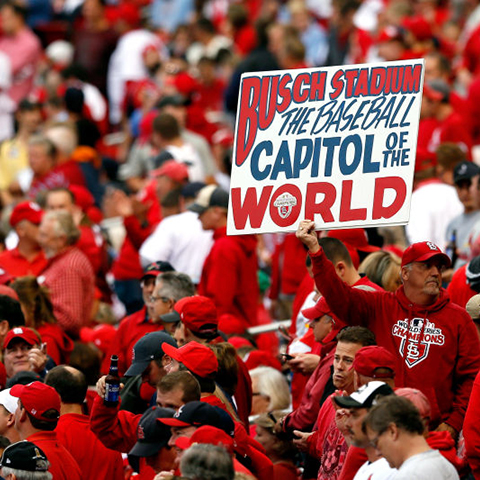How does Brand Loyalty and Brand Fanaticism Play Out on the Bottom Line?
I love baseball. My family loves baseball. We watch it together, go to the games, play it competitively in the youth leagues and have built a community program locally to give back to the community through baseball. We know the stats, love players beyond our home market and incorporate lessons from the game in our daily lives.
And we love the St. Louis Cardinals.
But as any Cardinal fan will tell you, it’s been a rough few years. We’ve watched our dominance of the Central Division shift to the hated Chicago Cubs two years ago and even fell behind the Milwaukee Brewers last year in the standings.
Now, anyone outside of St. Louis would tell us to relax. Our team has such a history of winning, that a few years is nothing and that we’ve set our expectations too high.
Fair point.
However, something else is happening in St. Louis that may be different than what is going on in other cities. The fan base of the St. Louis Cardinals are having their devout fanaticism of the team stretched and tried. Being the team furthest west for a time and powered by the 50,000-watt signal transmitting KMOX to countless houses around the sleepy Midwest on hazy summer nights has created a fan base beyond our city and a fan base that is considered one of the best in baseball. A fan base that will continue to watch, listen and buy tickets no matter what.
But for how long?
It is popular speculation that the Cardinals front office relies and counts on that fan base and believes they will continue to spin the turnstiles at the gates year after year no matter what the product they put on the field. The front office would deny this vehemently. But that theory won’t die. No matter how many times Mike Matheny, John Mozeliak and Bernie Miklasz tell us that they strive year after year to put the best product on the field they can and intend to compete for the pennant every year.
And that’s the dynamic that is going to be played out across Cardinal Nation these next few years. There is a fundamental branding question that will manifest itself into the zeitgeist of the fan base and the financial spreadsheets of the St. Louis Cardinals, LLC.
For those that haven’t been following closely, there is a rumbling that the St. Louis Cardinals have not done enough in the off-season to secure the type of players the fan base feel is necessary to take back the Central Division and contend for another World Series. The fan base has also watched others in our division make big moves to acquire players they feel will get them there. And the results are that the Cubs won a world series and the Brewers have overtaken us in the standings. Yet (as the popular theory goes) the Cardinals have not kept pace.
That can be frustrating to any fan of a team. However, here is the interesting angle for St. Louis and why this becomes such a fascinating real-live-action business case. Cardinal fans are consistently told through the front office and the media covering the team that the fans just don’t understand the business of baseball. If you can get a player at league minimum ($500,000) that puts up numbers similar to someone who is aging and has a larger contract (say $5M a year), you would be stupid to not go with the better “deal.” Is that extra point of WAR (wins above replacement) really worth an extra $3.5M-$4.5M in salary?
Again, as a fan of stats, analytics and bringing a bit of science into the art of thriving as a business, I would say that is a fair question. It is completely reasonable for the front office to have that conversation.
However, what seems to have fallen from view is the product that the customer is asking for. Baseball operations believes that the product is a team that wins and makes it to the playoffs. However they get there, with whatever players they choose. They are not completely wrong in that view. But to think that way in the era of the NBA superstar, in the era of players as brands, and in an era where the game is being played differently is flawed. The fan isn’t also looking for a team of good-players (no superstars) that somehow grind their way to the playoffs. The fans have consistently said that they would like a superstar (or two). In other words, the paying customer has given valuable feedback to the company on what type of product they would like to spend their money on.
Yet, the team has signaled to the customer base that they know what is best for them. “You don’t really need a superstar” is what they are telling the fan base. “We know what is best for you.” “We know how to win AND make a healthy margin while doing so” is the signal being received by the fan base loud and clear. But that’s not what the paying customers want to hear. Especially when the prices being charged to them for parking, tickets, food and beer continue to rise and rise.
Imagine going to a store and asking for an iPhone X. Would you accept a store that says “you don’t really want an iPhone X… you just need a smartphone that works and gets you the basic functionality of what you need each day and save you hundreds of dollars…” or would you move on to the next store that is willing to sell you want you actually want?
It came to a head for me when a listener messaged Bernie Miklasz on his show on opening day to say that he is expected to pay almost $500 for his family of 4 to go to a game now. Is it completely unreasonable for him to expect the team to spend his money on a player he’d like to see play in a Cardinals uniform? And while I enjoy Bernie’s perspective on many things (including his views on Matheny’s bullpen management and even his sympathies towards operations transactions), in this particular instance he brought up the “you don’t just spend money to spend money” argument.
And that leads me to the final thesis. This is what will be played out over the next few years and how it applies to the marketing and branding world:
What is the value (or value lost) of a fan base that loses its fanaticism for a team or brand? And how does that compare to the prospect of “spending money just to spend money?” In other words, if the value lost of a fan base is $10M in one year due to smaller viewer numbers, less tickets sold, less merchandise sold due to a fan base that doesn’t feel the team is meeting their needs–is that more or less than the amount of money they would have “wasted” on bringing in a big name that the analytics team in the front office doesn’t feel is a good value? In short, is $10M the price to pay in fan loyalty worth it in the name of saving $5M in salary of an “overpaid” player the fan base would want to see?
The St. Louis Cardinals are betting that they know best. That they know how to win and save money while doing it and betting they can do it with players they feel are best for the team. They are demurring somewhat on what the fan base (paying customer) is asking for and hoping that the fan loyalty that has been built up for years washes over the rough edges of not making big moves to improve the team.
If they beat the Cubs and go deep in the playoffs, maybe. But if they don’t (and I’m betting we don’t) we’re going to see the fan loyalty stretched and tried even further. And each stretch has a dollar consequence to the St. Louis Cardinals, LLC in lost brand loyalty. It will be an interesting case study to see just how far you can stretch brand loyalty before the consequence hits too hard financially. We’ll start to be able to put a real price tag on a fanatic vs. a casual fan.
Maybe sometimes, in the name of keeping the customers happy and taking their feedback into account in your product, you just have to “spend money to spend money.”
(Because it may actually be better for the bottom line)
Thanks for listening.



